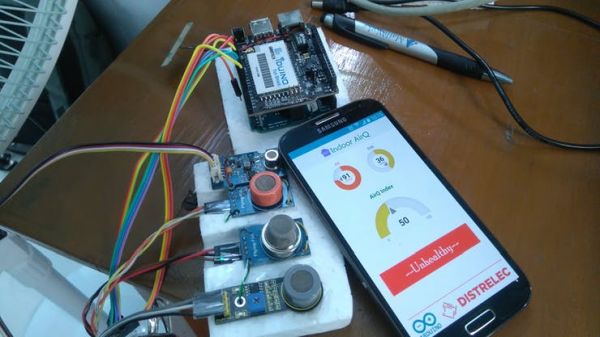An indoor air quality monitoring system for detecting toxic gases.

Things used in this project
Story
Introduction
Indoor air pollution has been consistently ranked by the US Environmental Protection Agency (EPA) and its Science Advisory Board to be among the top five environmental public health risks. Average person spends an estimated 90% of their time indoors so that poor indoor air quality (IAQ) poses a substantial risk to public health. Poor air quality may cause increased short-term health problems such as fatigue and nausea as well as chronic respiratory diseases, heart disease, and lung cancer. It is estimated that annual costs and productivity losses in US is $10 to $20 billion related to sick building syndrome, which is defined to describe acute health and discomfort effects that appear to be linked to poor indoor air quality and the time spent in a building.
In this project, we are going to present an indoor air quality monitoring system. Our system is connected to the Internet, and as a result, anyone can remotely visualize the air quality index form anywhere.


Possible Application Domain of This System
- Homes and offices
- Industries
- Remote sensing for firefighters
- Research and agriculture
- Hospital and clinic
- ICU unit
Things
- Wide range of IoT boards with WiFi (MKR1000 and Yún Rev2) and GSM/narrowband connectivity (MKR FOX 1200, MKR WAN 1300, and MKR GSM 1400). [For prototyping this project I used Arduino Leonardo with Yun shield]
- Gas sensors (MQ-2, 3, 7)
- Air quality sensor (MQ-135)
- Android device
- Mobile application development platform
- IoT-cloud
- Jumper wires
- Programming skills
- Arduino IDE/Arduino Web IDE
- Solar panel for green power source
Circuit Diagram

Air Quality Sensor
VCC to 5V pin of Arduino
GND to GND pin of Arduino
SIG to A3 pin of Arduino
MQ-2 gas sensor
VCC to 5V pin of Arduino
GND to GND pin of Arduino
SIG to A2 pin of Arduino
MQ-3 gas sensor
VCC to 5V pin of Arduino
GND to GND pin of Arduino
SIG to A1 pin of Arduino
Upload the Firmware
Download the firmware (source code) and upload it to the Arduino board. Before uploading make sure that, you have include all the libraries. Please refer this tutorials for connecting the Arduino Yun with Internet.
The git repository
https://github.com/Mohammadsalahuddin/indoor_air_quality_monitoring.git
Cloud Connectivity
Please refer the documentation section of thinger.io for cloud connectivity http://docs.thinger.io/arduino
***Attention***
The Mobile Application Collects data from my own iot-cloud account as a result if the device is offline, the mobile application does not shows any data (NaN). If you want to test the APK perfectly, mail me for powering up the device. Other wise please check the demo apps. The demo apps works without device. Thanks for yourkindunderstanding .
Demo

Device and demonstration
Future Plan
- Onboard indicator should be added for indicating the air quality index.
- Buzzer-based alarm while highly pollution is detected.
- Push notification for notifying the users during hazardous situation.
Reference
- US Environmental Protection Agency (USEPA). Indoor air quality tools for schools Communications guide. Available at http://www.epa.gov.
- H.S. Brightman and N. Moss. Sick building syndrome studies and the compilation of normative and comparative values. Indoor Air Quality Handbook. Editors: J. D. Spengler, J. F. McCarthy, and J. M. Samet, New York: McGraw-Hill, 2001.
- J.-J. Kim, S.K. Jung, and J.T. Kim.Wireless monitoring of indoor air quality by a sensor network. Indoor and Built Environment, 19:1:145-150, 2010.










